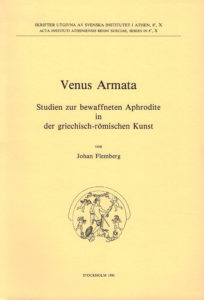 Published by the Swedish Institute at Athens. Distributed by Astrom Editions.
Published by the Swedish Institute at Athens. Distributed by Astrom Editions.
Venus Armata. Studien zur bewaffneten Aphrodite in der griechisch-römischen Kunst
Abstract
In the first part of this study, the evidence for the Oriental origin of Aphrodite is reviewed and it is suggested that the armed Aphrodite was introduced in Greece during the Mycenaean era and possibly, similar to her Oriental counterparts, had some connection with kingship. Next, the literary and epigraphic evidence of the armed Aphrodite in Graeco-Roman times is collected (31 testimonia) and discussed.
In chapter three, the monuments are dealt with, beginning with Archaic statuettes from Italy. Several interpretations of the Aphrodite from Epidauros are discussed, Hauser’s ‘Amyclaian’ hypothesis is rejected, mainly on chronological grounds. In the main, the chapter is an investigation of the statues representing the naked Aphrodite donning a sword. All the replicas of this type, as well as the representations on coins, are dealt with and several variants are discerned. The Nea Paphos replica, however, which shows the goddess with drawn sword, is considered to be an altered version of the main type. It is considered that the original was an under life-size, bronze statue, created ca. 100 B.C., probably in the area of the Aegean islands or Asia Minor. The suggestion that the artist was Hermogenes of Cythera is shown to be unsupported by the evidence.
In the light of the literary sources, the motif of the armed Aphrodite is interpreted as the disarming of Ares by Aphrodite; nothing indicates that the original meaning of the Archaic xoana was recognized in Classical and later times. In Roman art, where the political function of Aphrodite/Venus was more important, the same motif, viz. the disarming of Mars by Venus, was used, the most conspicuous example being the iconography of Venus Victrix.
Contents
Vorwort (p. 7)
Abkürzungen (pp. 9–10)
Einleitung (p. 11)
Die bewaffnete Göttin (pp. 12–28)
Aphrodite Strateia und Verwandtes
Aphrodite und Ares
Venus
Testimonia (pp. 29–42)
Die Denkmäler (pp. 43–113)
Die Aphrodite von Epidauros
Die Aphrodite von Arles
Gemme aus Eretria
Die Aphrodite des Pergamonfrieses
Die Büste von Kalydon
Statuetten aus Athen
Die nackte Aphrodite mit dem Schwert
Die bewaffnete Venus
Zusammenfassung (pp. 114–115)
Abbildungsnachweise (p. 116)
Übersetzungsnachweise (p. 117)
Index (pp. 118–128)
Standortregister (p. 129)
Bibliographical information
Johan Flemberg, Venus Armata. Studien zur bewaffneten Aphrodite in der griechisch-römischen Kunst (Skrifter utgivna av Svenska institutet i Athen, 8°, 10), Stockholm 1991. ISSN 0081-9921. ISBN 9789179160227. Softcover, 129 pages.
Reviews
Opuscula Atheniensia 20, 1994, 290-293 (Olga Palagia, Siri Sande).

No Comments
Comments are closed.